
The B2B Marketing Campaign Checklist in 10 Simple Steps
Going to market with only a set of ideas about how to sell your product is a hit-or-miss proposition – usually a miss. For a successful marketing campaign, you need to start with a good plan. Here’s a checklist of 10 things that should be covered before launching any marketing campaign.
1. Identify your business goals
Though the ultimate goal of any marketing campaign is revenue from sales. But sales goals are very different from marketing goals. Marketing goals are about how many prospects you can bring in to look at your offering, and through which channels they’ll get there. Goals could include things like building an email list of X contacts from your specific target audience, participating in X number of regional trade shows to drive X amount of new contacts, engaging a certain number of users on social media, and/or, X% of conversions (visitors to leads) from a campaign. Whatever specific goals suite your business model, make sure your marketing strategies will be aligned with achieving your goals.
2. Know your prospects’ sales cycles
As a marketer, it’s your job to understand the sales process and try to improve sales by bringing the right kinds of prospects into the pipeline. By researching and understanding your prospect’s sales cycle, you get a better understanding of their decision making process. Are purchases always planned for the next fiscal year’s budget, or is it more as-needed? How long is the approval cycle, and how long does it take? And who is involved in the buying process? You may need to create some separate “Convince the Boss” messages if line managers do the shopping, but a VP has to approve.
3. Market with your strengths
Identify what your team does well and build that unique differentiator into your marketing campaigns. If you have great writers, then clever copywriting could be your secret weapon. If you’ve got talented designers, emphasize web graphics or colorful flyers for getting attention.
4. Collect your assets
It may not be necessary to start from scratch. Discover what other techniques your company has used in past campaigns: videos, infographics, case studies, brochures, testimonials, slideshows, white papers, software demos and trials, etc. Many of these can be repurposed and implemented into your inbound marketing campaign.
5. Analyze the competition
First, assess the entire competitive field, and then choose one or two leaders whose product, service or business model most closely resembles yours. Take notes on how you can position your company to differentiate with a better and unique value proposition. Then, deconstruct the marketing techniques they used to achieve their top position: website design and landing pages, content, social media and search presence will all provide you with valuable insight. What keywords have they used to build their SEO strategy? There are tools for this like SEMrush, but often you can identify their main keyword terms by looking at their page titles that appear at the top of your browser window.
6. Develop a clearly stated value proposition
Take those competitor notes and look at how your company does the same or superior job either cheaper, faster, more conveniently, or more reliably. It’s not about your company’s product – it’s about HOW your company’s product makes your customers’ lives, or jobs, easier or better for THEM. So when you state your value proposition, make sure it’s created around your buyers, not around you. Incorporate this message prominently in every marketing channel you plan to use and with the same phrasing so it becomes memorable.
7. Identify KPI’s and set team benchmarks
Use trial and error to see what is the best time, platform and channel for the best response rates from your targeted market – and be patient. You don’t want to change timing and strategies too quickly, because you will be looking for trends and changes in numbers over time as you play with each variable. A/B testing is always a good idea, especially at the start.
8. Develop a content strategy
All of this work is based around the content you’re trying to market! Rich content not only elevates your search rankings but more importantly, it establishes you as an authority in your field, engages trust, and is a key factor in sales conversion. Make the most efficient decision around who should be writing your content, editing the content and posting it. Host a shared publication calendar with deadlines that everyone can reference. Also include themes that can be promoted at certain times of the year, based on your customers’ typical sales cycles.
9. Create buyer personas and design messages that resonate
Take the time to learn about your buyers. Who is the ideal customer? What are their common pain points and desires when evaluating a solution like yours? Put yourself in their shoes, their job, or their mindset. It’s often helpful to interview these people directly to learn the words they use, what triggers them to buy and the process they go through when searching for different solutions to their problem. Then, think of the campaign from the receiving end – what’s the biggest pain you can eliminate for them? How will your service or product make that headache go away?
10. Use marketing software and/or an outsourced team
There are a lot of marketing tactics and strategies mentioned above, and it can look daunting if you are limited on experience or marketing staff. Marketing automation software has dramatically simplified the ability to capture, monitor, score and nurture your leads based on where they are in their buying process. But the set up of these tools isn’t always simple and it’s not always efficient for every business to buy the best automated marketing system, or to train your own staff to use them. It pays to outsource a lot of the strategy and technical work by hiring a full service marketing agency as your partner. They can also provide data and experience to make future campaigns run more efficiently.










